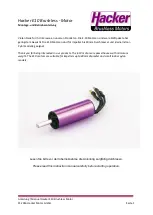
22
INSTALLATION AND MAINTENANCE
CPLS drip-proof 3-phase induction motors
4240 en - 2014.09 / b
LEROY-SOMER
6.3 - CPLS 160 and 200 HV3 motors
6.3.1 - Dismantling the motor
It is advisable to identify the shields in relation to the stator.
The
bearing retainers, valves and trap are different at the non
drive end and the drive end.
- Remove the 3 CHC screws from the encoder protective cover
(13), the encoder support (12) is also released.
- Loosen the encoder driving ring screw (at the encoder
drive end).
- Remove the encoder (14) from the motor shaft with its
support (12).
- Undo the CHC screws holding the NDE trap (11), and
remove it.
- Remove the forced ventilation unit (17) by undoing the
4 screws on the base.
- Open the terminal box (15).
-
Mark the position of the stator connection cables in the
terminal box.
- Disconnect the accessories (sensors, space heaters, etc).
- Disconnect the stator connection cables by unscrewing
the nuts.
- Remove the terminal plate (16).
- Remove the terminal box (15) by undoing all 4 screws, then
the terminal box support plate, by undoing all 4 countersunk
head screws (this will make reassembly easier).
- Remove the key, taking care not to damage the keyway.
- Undo the CHC screws holding the DE trap (10), and remove it.
- Loosen the grub set screws on the DE (8) and NDE (9) valves.
- Unscrew the DE (8) and NDE (9) valves. (The smooth radial
drill holes allow a tool to be inserted in order to loosen the
valves).
- Unscrew the 4 nuts holding the end shields (2) and (3).
- Undo the DE (6) and/or NDE (7) inner bearing retainer fixing
screws (if necessary).
Take care with the sensors during
this operation!
- Using a bronze drift, remove the shields (2) and (3) by tapping
gently on the inside of the flange (above and below the shutters –
inspection doors). During this operation, support the shields with
a lifting system.
Once again, take care with the sensors!
- Remove the rotor from the stator (1), taking care not to touch
the winding.
- If necessary (1), take out the bearings (4) and (5) using
a bearing remover, while protecting the end of the shaft
extension with a washer. Avoid knocking the running surfaces
of the shaft.
(1) The special high-speed bearings must only be removed
when they are replaced.
6.3.2 - Before reassembling
Stator:
- Remove all dust from the stator: if the winding needs to be
cleaned, a suitable liquid must be used: dielectric and inert on
the insulating components and the external finish.
- Check the insulation (see section 2.1) and if necessary, dry
the stator in a drying cabinet.
- Clean the spigots thoroughly, and remove all traces of impact
on the mating surfaces.
Rotor:
- Clean and check the bearing running surfaces. If they are
damaged, renew the running surfaces or change the rotor.
- Check the condition of the threads, keys and their housings.
End shields:
- Clean off any traces of dirt (old grease, accumulated dust, etc).
- Clean the bearing housings and the spigot.
- If necessary, apply anti-flash varnish inside the shields.
- Clean the bearing retainers, the grease valves and the waste
grease traps.
Mounting the bearings on the shaft
Please contact Leroy-Somer to obtain the exact reference
number for the bearings to be used. This operation is extremely
important, as the slightest indentation of a ball on the bearing
tracks would cause noise and vibration.
Lightly lubricate the running surfaces of the shaft.
There are several ways of mounting the bearings correctly:
- Cold state: the bearings must be mounted without any impact,
using a spanner
(do not use a hammer)
. The force applied
must not be transferred to the bearing track. You should
therefore use the internal cage for support (taking care not to
press on the seal shield for sealed bearings).
- Hot state: Heat the bearing to between 80 and 100°C: in
a drying cabinet, an oven or on a heating plate.
(A blowtorch must never be used for heating, just as an oil bath
must never be used for heating permanently greased bearings).
6.3.3 - Reassembling the motor
Care must be taken to ensure that the stator is replaced in
its original position
so that the stack of laminations is centred
correctly, and the rotor and stator are aligned correctly.
During reassembly, always check that the various seals are in
the correct position, and replace them if they are in poor
condition.
- See section 6.3.2 before reassembly.
- If necessary, insert the inner bearing retainers and reattach
the sensors if they have come undone.
Содержание CPLS 112
Страница 27: ......







































